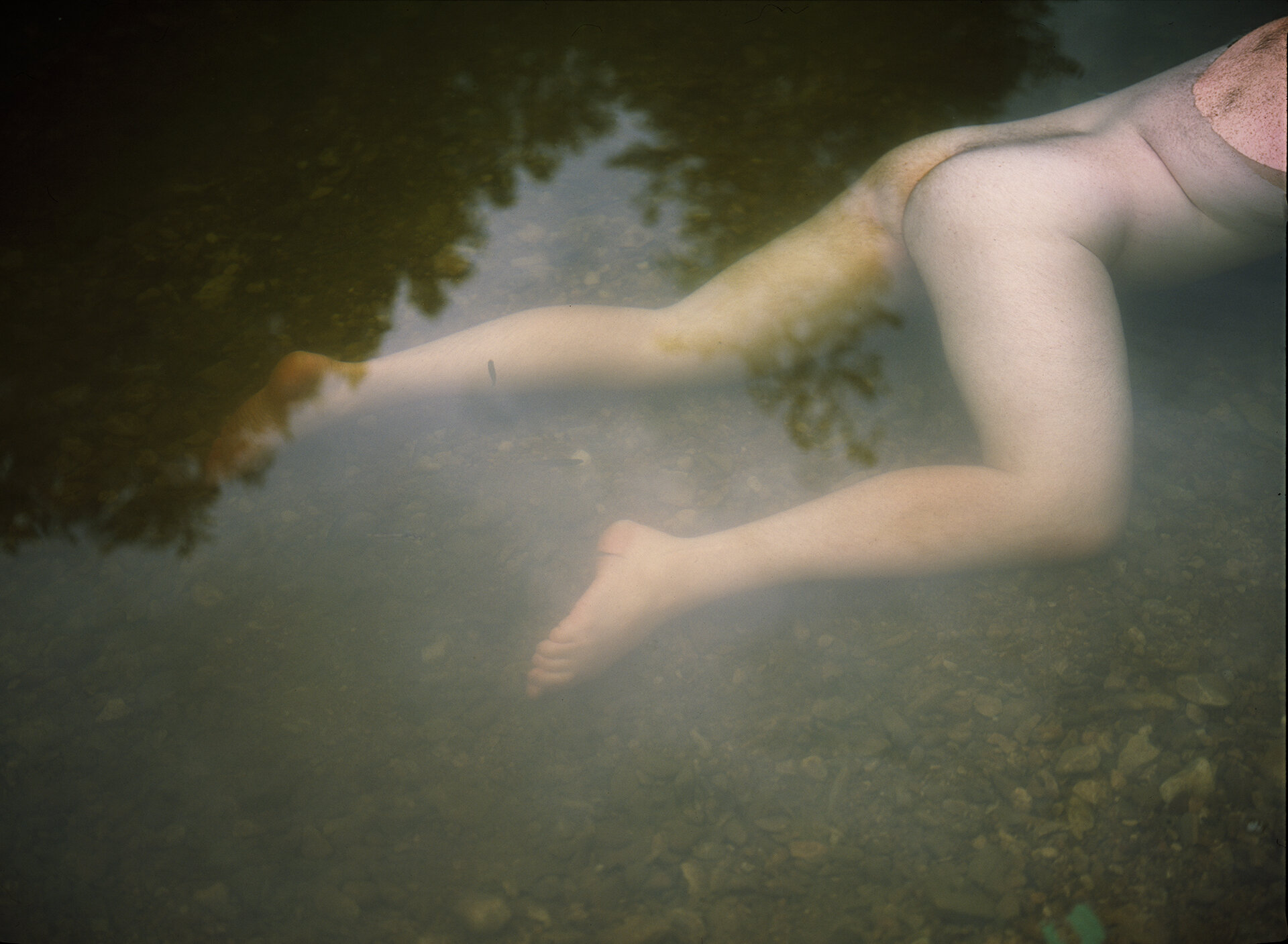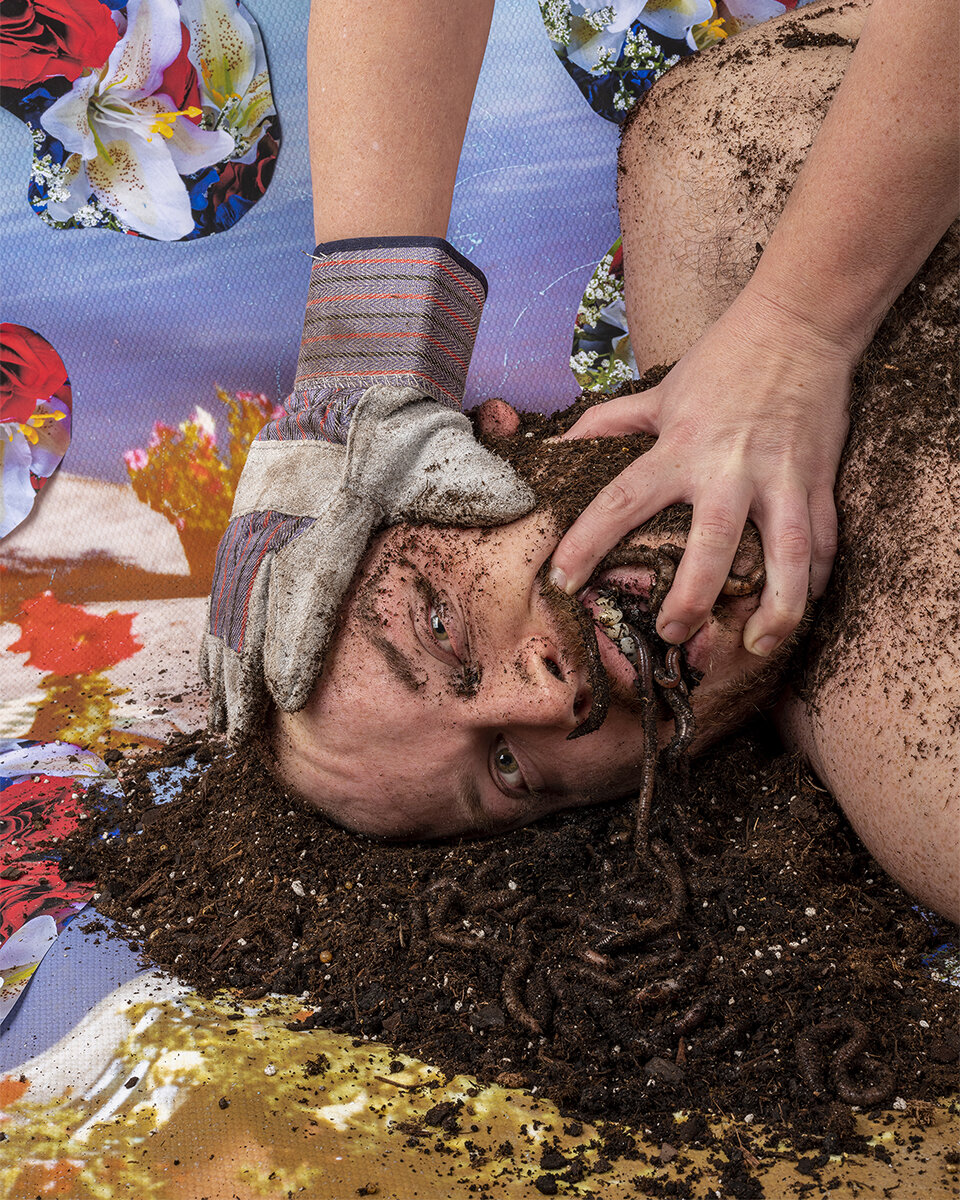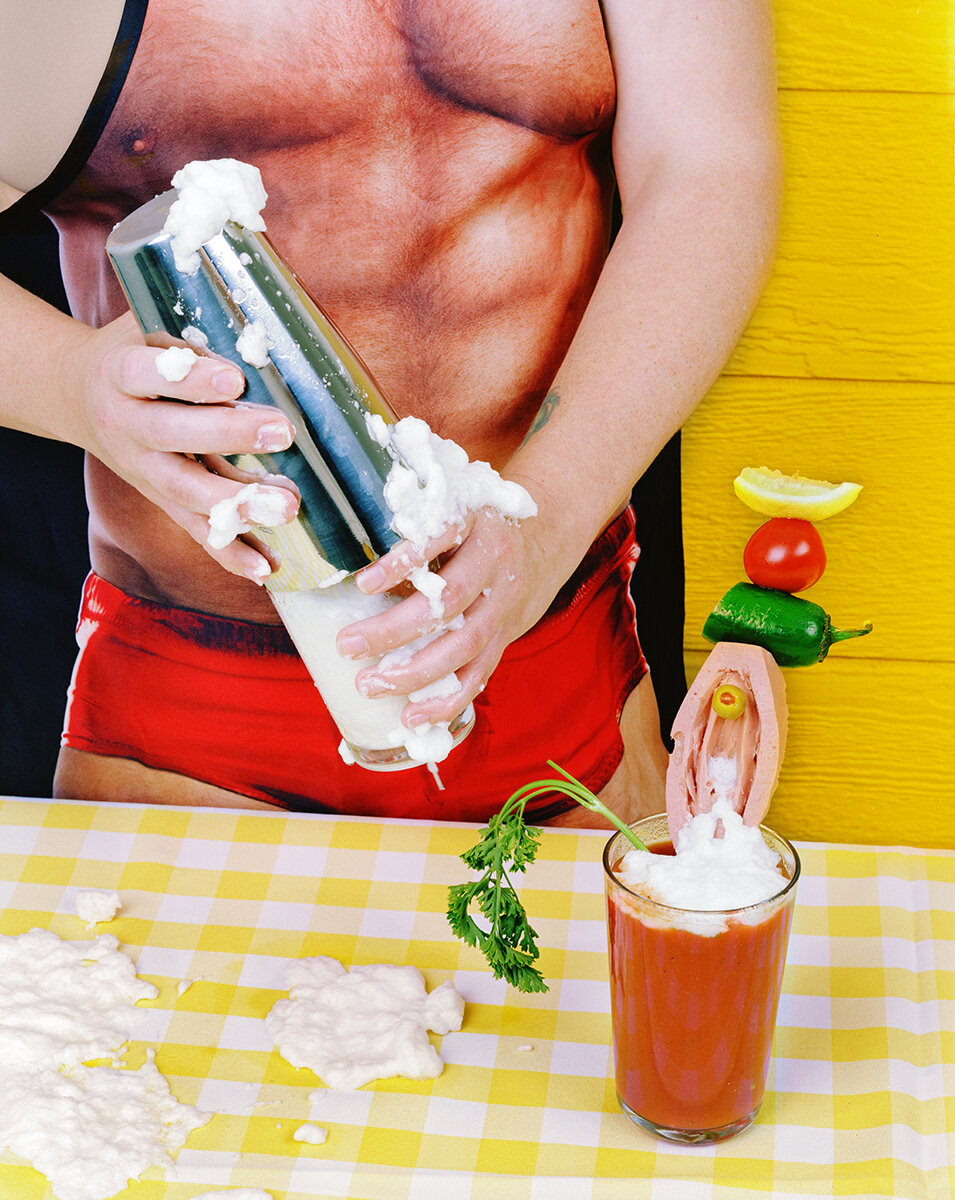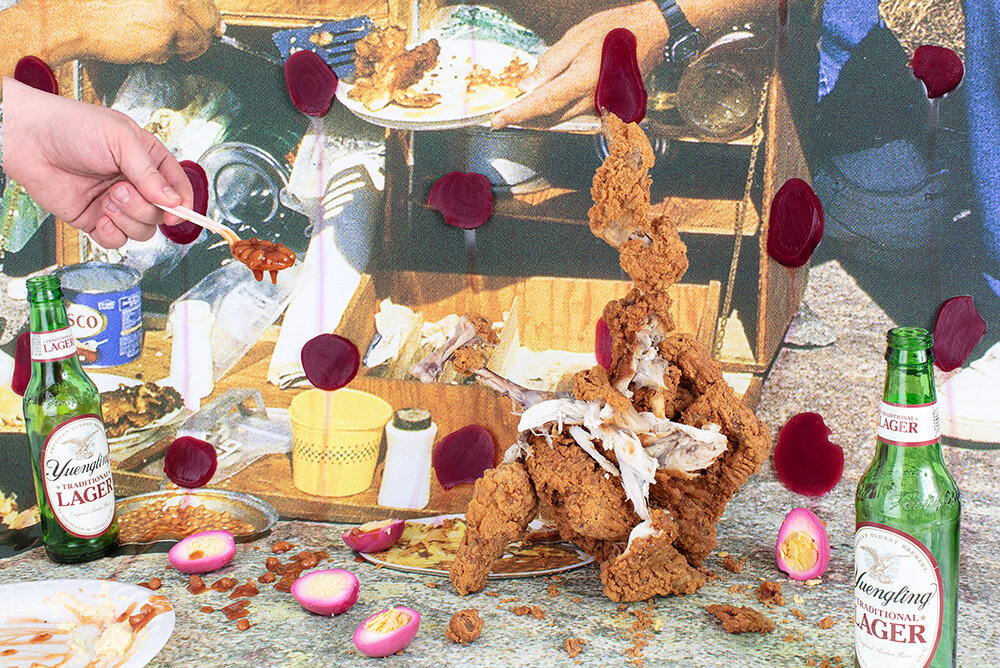The Chicken Or the Egg…
Words by Aubrey Porterfield
All Images Robert P Gordon and Ashley Kaye
Note: After this was published Robert transitioned to life as a woman and goes by Isla. This essay is retained in its original form.
The artists at home, inspired by Kat Wilson’s Habitat project
Ashley Kaye and Robert P Gordon hail from the Lehigh Valley in Eastern Pennsylvania. For most natives of this Northeastern region, the “South” conjures up images from country music videos: billowing American flags, cherry pies, cowboy boots, and pick-up trucks. But, for these transplants, the quiet woods of Northwest Arkansas provide shelter from pressures of gender conformity and religious conservatism. In nearby forests they stumble upon things that spark memory and tease the appetite. Rob and Ashley mix discovery with conscious arranging, exploring the permeable boundary between abandon and control. Moving to the rural South has put them in touch with aesthetic influences that resonate with their interests in memory, gender fluidity, and the body. The iconography of the South appears in their pulpy photographs of bologna sandwiches and glossy hotdogs on cornflower-blue gingham. Ashley’s work evokes the bold postmodern hedonism of advertisements that treat the South as brand: think Country Crock or Smucker’s. More relevant to Rob’s work is the Southern Gothic tradition, as his photographs arrest objects in states of decay, blending vitality with morbidity. For both artists, distance from their origins—temporal as well as spatial—has made confrontation with the past more fruitful. Here, they have found space for their queer partnership, which revolves around comfort and acceptance. Within this relationship, they also find the safety to critique and appear in each other’s art.
Cairn, Ashley Kaye, Archival Inkjet Print, 2018
Drawing Near, Ashley Kaye, Archival Inkjet Print, 2019
Corn Gag, Ashley Kaye, Archival Inkjet Print, 2019
If “Don’t play with your food” is one of the first taboos taught to children, Ashley’s portraits in Glut and Guzzle fly in the face of the forbidden. Her photographs present food and the human body in disarray together: egg yolks ooze over a face; hands prod and pull at a chicken carcass; a person’s head (Rob’s) is nuzzled by sausages, shrimp, and corn on the cob. Never quite sliding into place as sexual fetish, the food makes the viewer want to knead or squeeze something. Some photographs stage a symbolic revolt against the confining gender expectations Ashley consumed as a child and teenager. Other photographs present over-indulgence as the logical correlative of these gender-normative strictures. In one, Ashley stands behind a counter, a deadpan expression on her face, strapped into a white apron and blouse. She holds an intact chicken egg aloft in one hand, a broken egg with yolk running through her fingers in the other.
Dreaming, Ashley Kaye, Archival Inkjet Print, 2020
Having grown up in a close-knit Mormon community, Ashley has wrestled with the dogma that motherhood is every woman’s destiny. Taught to keep her body pure from sexual gratification, she grew up with punishing shame. This photograph presents a rejection of fertility, and its power comes from the objects in the background. Behind Ashley, a white wall barely registers her shadow; a man’s chest, framed in pink, appears where we would expect a clock or a portrait of a person. The surreal is framed, literally contained, within a confining “normal.” In a way that is hard to explain, this reserve appears again and again across Glut and Guzzle, as images of pleasure and surrender are seized by formal arrangements that resemble the conventions of Classical nudes and statues. In this sense, Ashley’s work returns repeatedly to the moment when the subject breaks free of constraints, only to find that appetite needs some form of limit to feed its frenzy.
Wormbag/Bagworm, Robert P Gordon, Archival Inkjet Prints, 2019
Delta, by Robert P Gordon, is an anthology of memory work. Inspired by recollections of childhood excursions to lakes and woods, Rob’s work reflects the Southern Gothic’s focus on landscapes saturated with history. In one photograph, a boot dangles before a tree branch, the rubber sole facing the spectator. The same grey and green as the foliage behind it, the boot is almost camouflaged; but the taut shoelace it hangs from cuts the image, creating uncomfortable tension. While stillness prevails, many photographs convey a sense of suspended agitation: in one, a boat’s motor, partly obscured by murky water, looks about to rumble into action. Similarly, images of slight touch suggest sexual arousal but not its fulfillment. Earthworms on a groin covered by white cotton underwear remind us of death as well as pleasure. This image recalls an oft-cited impression in William Faulkner’s The Sound and The Fury: a young girl, Caddy, muddies her underwear climbing a tree. The memory of her soiled drawers stretches across the years, tethering her brothers, Benjy and Quentin, to this particular childhood moment. This elastic power of memory shapes Rob’s work in Delta as his process moves him back and forth across time. Encounters with objects in the natural world—a pile of leaves, a spider’s web—spark involuntary memories, which he then focuses on and consciously pursues in staging, photography, and collage. Like the deer antlers half-submerged in pond murk in one of his pieces, these memories thrust themselves forward through the sensory fabric of the world and, alternately, recede into the unconscious. His work is about tracing them back and, in the same gesture, freeing himself from pressures that made the original experiences difficult to begin with.
Untitled (Boot Straps), Robert P Gordon, Archival Inkjet Print, 2019
Short Shaft, Robert P Gordon, Archival Inkjet Print, 2019
“The most telling resonance between Glut and Guzzle and Delta is the way both set the viewer on edge by taking the trappings of comfort and nostalgia and pushing them into disgust and nausea.”
Spring Planting, Robert P Gordon, Archival Inkjet Print, 2019
Blackberry Madness, Ashley Kaye, Archival Inkjet Print, 2019
The most telling resonance between Glut and Guzzle and Delta is the way both set the viewer on edge by taking the trappings of comfort and nostalgia and pushing them into disgust and nausea. Clicking through the images of “Delta” feels, at first, like watching a slideshow of someone’s decades-old summer vacation photographs. Snapshots of picnics, beers, makeshift steps descending to a lake’s edge. A dead fly in a honey-color liquid seems the perfect metaphor for the longing to stop time. But the sequence of images increases our unease, as figures of death gradually pop out of the photographic flatness. A faded photograph of a boy holding his daily catch of fish on a string gives way, a few frames later, to a jagged statue of bright green fish skewered together, like a macabre scaffold superimposed on another faded lake photograph. Advancing a few more slides, the viewer confronts the most jarring image in Delta. Rob’s bare shoulders and head are pressed by anonymous hands into a mound of dirt and earthworms that squirm in his open mouth. Grimacing, Rob submits to this grotesque planting, his eyes taking in the hands, the worms, the viewer—all with a look of absolute knowing. This photograph invites comparison with two from Glut and Guzzle, both of which feature Rob’s neck and face smeared in food. In one, his face is covered in dark red berry juice, and his hand obscures his mouth while more berries squeeze through the creases between his fingers. If Ashley’s running egg yolks recall squandered fertility, the berry smear suggests menstrual blood. In the other, Rob’s face is caked in hot-pink, green, and peach-tinted icing, while his head and eyes tilt backward. In both, Rob’s appear to have rolled back into his head in ecstasy or a zombie-like trance.
Mean Green, Robert P Gordon, Archival Inkjet Print, 2020
Better Than Sex, Ashley Kaye, Archival Inkjet Print, 2020
The images register total abandon to the enjoyment of appetite and, oddly, submission to the artist’s control. Holding in mind the model’s patience and the subject’s enjoyment, the viewer sees a strange blend of concentration and surrender. At the same time, the heavy iconography feminizes the subject through the connections to menstruation and wedding cake. The unnerving effects of these photographs, like the wormy one from “Delta,” come from their tense juxtaposition with elements that are so familiar to a conservative sense of American life and gender performance. From the picnics and milkshakes that recall a white, middle-class 1950s idealism to the camping excursions where boys learn to be boys, these collections evoke heteronormative utopias. Whether these settings are more “Southern” than they are simply American is a difficult question to answer, but it is through their detour to the literal and fantastic South that Ashley and Rob thwart that particular brand of utopia. They do so by staging and exploding the body’s desires and limits, especially its appetite for food and its final condition as food.
It makes sense, then, that portraits of food are the finale for both Glut and Guzzle and Delta. The former ends with a campy image: Ashley, wearing an apron printed with a “manly” set of washboard abs, holds a foaming milkshake that is about to join an overly-garnished Bloody Mary on a yellow gingham-clad table. The latter closes with a surreal reconstruction of a picnic in front of a grainy, enlarged photograph. In the foreground, a fried chicken has been taken apart and put back together in a faintly humanoid form. From the extreme left of the frame, a hand extends a plastic spoon, full of baked beans, as if offering it to the reconstructed chicken. Both photographs play with the tropes of Baroque vanitas paintings, reminding us that mortality provokes desire and satiety tends toward decay. At the same time, both stage the uncanny gesture of feeding the food: Ashley’s, by presenting the cocktail with a tempting skewer of meat and vegetables; Rob’s, by ladling beans toward an already-cooked chicken. Across the United States, the South is known as the heartland of American cuisine, especially its comfort food. The myth our country fosters of the South is a romance with food that connects our present to an idyllic past. There, the feast was raised and slaughtered by hard men, baked and basted and glazed by child-bearing women. In an era when the phrase, “Make America Great Again” buzzes across the airways, perhaps this faith in consumption as a way to normalize gender roles is resurging. That’s why the thwarted nostalgia of Delta and Glut and Guzzle is so timely: it gives us pause, reminding viewers that the most tempting, teasing treat is the one of a fantastic past. The antidote to this mythology is the involuntary memory aroused and pursued in these works.
The Civilized Way to Court the Ladies, Ashley Kaye, Archival Inkjet Print, 2019
The Chicken or The Beet Egg, Robert P Gordon, Archival Inkjet Print, 2019













